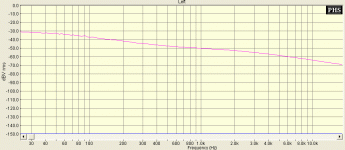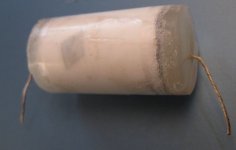Salas said:2. Medium MC 1mV.
Splendid job Salas !
I am using the 28v medium version but there are some differences regarding the following resistors:
R2 = 27r
R6 = 47r
R9 = 220
R11 = 1k
Would you please explain the reasoning behind these differences (Particularly regarding R2 and R6) ?
Ricardo
PS: D1 mod may now be considered fundamental.
Here you have my latest notes:
Imediate reduction of noise floor.
Lost the bass bloom
Bass much more detailed with higher speed
Very sweet trebble without harsness.
Significative stereo image improvement
Less transient distortion
Better dynamics
No noticeable "timbre" variation
Tone is a little "lighter" due to the lack of bass bloom (Subjective impression)
Noticeably Wider sounstage
More stable instrument placement

nicoch46 said:HI Ricardo , mod_man
I read that put the Rload back on head shell (non fixed) sound better ,we can put on arm pod for fixed headshell....
Do you mean removing rload from riaa and place it on the headshell ? (Might be a good idea
 )
)RCruz said:
Splendid job Salas !
I am using the 28v medium version but there are some differences regarding the following resistors:
R2 = 27r
R6 = 47r
R9 = 220
R11 = 1k
Would you please explain the reasoning behind these differences (Particularly regarding R2 and R6) ?
Ricardo
They are a bit different due to 1mA more suggested IDSS in now circuits, because the mean average from Spencer got higher. R9 was 220R in your case, due to 220uF available by Lee back then, so to keep RC time constant roughly the same as with 100R, 470uF. Its the same circuit.
RCruz said:Tone is a little "lighter" due to the lack of bass bloom (Subjective impression)

Maybe its time to readjust VTA or Rload, since you have done those based on the previous situation?
nicoch46 said:Ricardo for fixed headshell better put were the the cartridge wire meet the phono cable on TT
Soon I will be working on the TT insides (New wiring, new phono plugs, new suspension coils.... Some damping and maybe a new base.
I will try the rload mod in due time.
Ricardo
Salas said:
Maybe its time to readjust VTA or Rload, since you have done those based on the previous situation?
I recently recived new fixing bolts for the SME 3009.
I will reajust VTA and report the differences.
Ricardo
PS: The riaa is very silent right now so I am rediscovering my old vinyl pressings.
Outstanding contraption

Salas said:What is the type and sensitivity of your speakers? What amp and preamp you have? Do you know their gain in dB? How can you characterize the sound of your system right now? Heavy, thin, or neutral?
Because I know the DL103 and the cascode or not I am trying to give you the best advice. Let me know about the questions.
Hi Salas, thank you for your reply.
Speakers are a modest pair of Mission M72s, 8-ohm sensivity nominal, though can dip to 6-ohm according to some reviews.
Pre-amp is currently a totally rebuilt Quad 34 - ouput is 1.1V I believe.
Power-amp is a Greg Ball GB150D 150W power amp
I'd describe the system sound at present as fairly neutral - perhaps erring slightly on the side of warmth due to the Quad 34. Terrific dynamics and bass extension and a crisp clear treble.
Hope this helps
- John
Hi Salas,
Have you plotted the accuracy of your RIAA network? Do any of the components need to be tuned for different layouts. Sorry if this has been covered before.
This has been a great thread now about a pre-amp using the same topology same regulator, of course.
Regards,
Jam
Have you plotted the accuracy of your RIAA network? Do any of the components need to be tuned for different layouts. Sorry if this has been covered before.
This has been a great thread now about a pre-amp using the same topology same regulator, of course.
Regards,
Jam
Yes, I did. It is slightly tailored and sounds best for Steve Bench tube cascode and my ''Valve Itch'' Mu follower too, after many subjective tests with many TTs and MC carts in different systems. Of course this proves that the curve is good for different layouts, since it is good for different phono pre amps as well. Each version or different preamp has other values for some critical components in conjunction with the input and output impedance seen in each case. But they are all measured to conform with my ''reference'' curve. ''Lost Neumman time constant'' has been tested in all preamps, but it always sounded rather harsh BTW. Hence dropped.
You can see my Riaa curve measured in the attachment.
You can see my Riaa curve measured in the attachment.
Attachments
russian loved
From jon L audiocircle
I was able to test the "nude" K72 that has been de-cased and de-posted (courtesy of Josh K), and I must say this version loses most of the hardness and etch of the stock unit. After a long break-in, the sound is almost creamy-smooth in the low-treble and upper-midrange while the detail and dynamics remain.
What I have always liked about the Russian teflons, including K72 and FT3, was that while they don't quite have the air and refinement of the VCaps or Auricap Teflon, they actually had a bolder and more robust presentation that projected more forward with arguably a more involving mien. Now with the nude mod adding smoothness, K72 must certainly be *the* giant-killer, right?
Well, almost. The nude mod ended up sounding a little too creamy and smooth up top. There was terrific detailing right up to the midrange, but the triangles, cymbals, and violin's upper harmonics did not ring clear in sparkling fashion. Wait! I have heard a very similar sound previously... It was the Audiocap Theta, and adding a small FT-1 teflon bypass capacitor was the sweet answer then, so I tried the same with the nude K72.
Holy Batman, now things were really cooking. Since FT-1 is basically the same internally as K72, adding the bypass did not result in any appreciable incoherence or distontinuity, just adding that last breath of air, upper harmonics, and sparkle. The resulting sound was at once robust, dense, detailed, and airy, while being as smooth as baby's behind. I really liked the results, and if you have some K72's, I highly encourage you to crack open the case and add the FT-1 teflon bypass.
From jon L audiocircle
I was able to test the "nude" K72 that has been de-cased and de-posted (courtesy of Josh K), and I must say this version loses most of the hardness and etch of the stock unit. After a long break-in, the sound is almost creamy-smooth in the low-treble and upper-midrange while the detail and dynamics remain.
What I have always liked about the Russian teflons, including K72 and FT3, was that while they don't quite have the air and refinement of the VCaps or Auricap Teflon, they actually had a bolder and more robust presentation that projected more forward with arguably a more involving mien. Now with the nude mod adding smoothness, K72 must certainly be *the* giant-killer, right?
Well, almost. The nude mod ended up sounding a little too creamy and smooth up top. There was terrific detailing right up to the midrange, but the triangles, cymbals, and violin's upper harmonics did not ring clear in sparkling fashion. Wait! I have heard a very similar sound previously... It was the Audiocap Theta, and adding a small FT-1 teflon bypass capacitor was the sweet answer then, so I tried the same with the nude K72.
Holy Batman, now things were really cooking. Since FT-1 is basically the same internally as K72, adding the bypass did not result in any appreciable incoherence or distontinuity, just adding that last breath of air, upper harmonics, and sparkle. The resulting sound was at once robust, dense, detailed, and airy, while being as smooth as baby's behind. I really liked the results, and if you have some K72's, I highly encourage you to crack open the case and add the FT-1 teflon bypass.
Attachments
FT3 sounds like a naked K72 or better without the stripping. If you cut both, you will see that the K72 has thinner Teflon. The difference in the highs is because of K72's sturdy steel (magnetic) can with glass sealed ends. It has some ceramic spacer stuff between the foil and the can also. The FT3 has thin aluminum can and eyelets. FT3 is bigger for same nF and has awkward flat legs.
While the differences are small as a percentage, there is a different flavor between the two capacitors. I like the K72 for being smaller and well packaged, having excellent speed and clarity. FT3 is just more fleshy and natural in the highs. Both are very serious capacitors, and undercut the brand name ones in a BIG WAY when considering value for money. Alas, they don't come in uF range. Using the FT-1 bypass discussed in the posted review over an FT-3 would be a hassle free experiment I guess.
While the differences are small as a percentage, there is a different flavor between the two capacitors. I like the K72 for being smaller and well packaged, having excellent speed and clarity. FT3 is just more fleshy and natural in the highs. Both are very serious capacitors, and undercut the brand name ones in a BIG WAY when considering value for money. Alas, they don't come in uF range. Using the FT-1 bypass discussed in the posted review over an FT-3 would be a hassle free experiment I guess.
I fully agree with these statements. (I have been using both kinds as bypass on the output caps of the CDP and FT3 sounds bigger, more extended and much more fluid... K72 is very incisive and good for guitar riffsSalas said:FT3 sounds like a naked K72 or better without the stripping.
I like the K72 for being smaller and well packaged, having excellent speed and clarity. FT3 is just more fleshy and natural in the highs.
nicoch46, I only had time to reset VTA..... Sound regained fullness and integration just by lowering the arm 1 card. (2 cards is too much, loosing focus, detail and gaining some bass bloom, so I believe I reached the best possible setup)
"I do not judge by appearance alone - ugly looking things are sometimes much better than the pretty ones"
Ricardo
- Home
- Source & Line
- Analogue Source
- Simplistic NJFET RIAA

